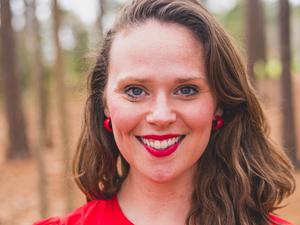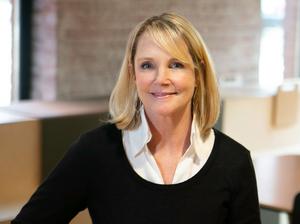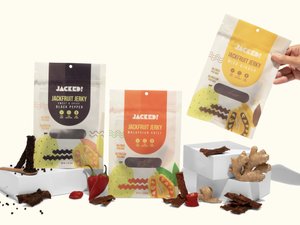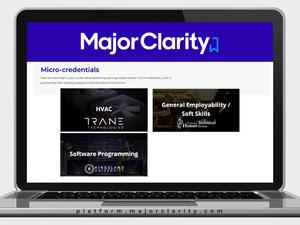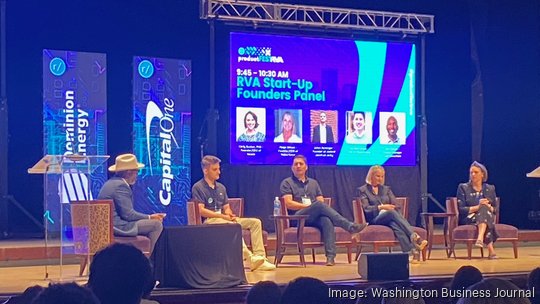
A group of local founders speaking at rvatech’s ProductFest on Wednesday at Dominion Energy Center stressed the importance for startups to first understand their customers and develop a quality product before scaling.
Carly Buxton, co-founder and CEO of maternity services startup Nessle; Paige Wilson, founder and CEO of senior services startup Naborforce; Julien Reininger, founder of Jacked! Jackfruit Jerky; and Joe Belsterling, CEO of online learning platform MajorClarity, all participated in a roundtable discussion.
Naborforce offers a tech-based platform that links aging adults to a network of "nabors" for social companionship, engagement and on-demand support with errands and other tasks. Wilson said the company spent two years understanding the market and developing a product. The process involved a lot of listening and forced the company to limit investments in technology.
Wilson said the original website appeared technology enabled on the front end, but on the back end was often Wilson doing spreadsheets by hand. The technology created the connections between people, but it was not the reason the business grew. It grew because it solved a problem, Wilson said.
“Before you grow out and build the technology… go out and test it as cheaply as you can,” Wilson said.
Buxton started Nessle to help new mothers connect with maternal services. She has slowly built the company and is still refining the product. Buxton said she wants to establish a product-market fit before she really focuses on scaling.
“We started on Wix [a website builder],” Buxton said. “I wanted to test demand. … It’s so easy to convince yourself that it’s not taking off. Not enough people are seeing it. And I started to convince myself that I needed more solid tech.”
She started with a Google form for people to sign up. She had people convince her that she needed to invest in the platform and upgrade beyond the Google form. She invested in an upgrade but said it was “terrible advice.” The product and not the technology built the company.
“We had already built the product,” Buxton said. “We didn’t need a dev shop to build it. We had the same conversion rate. My takeaway from that is do it yourself as long as you possibly can.”
Belsterling said the key is creating that “magic moment” when customers are using the product. His company helps high school students understand a potential career path. For him, the magic moment is getting school administrators to use the product. He said the company markets through traditional sales channels, but the hands-on experience is the reason the company has been successful.
He used the example of a school administrator who sat down with his daughter and used the product. The daughter loved the product, and the administrator placed an order the next day.
“Don’t try to build before you know what to build, and don’t try to market before you know what to market,” Belsterling said. “A lot of people fall in this trap of overthinking about scalability right off the bat. You might end up spending tens of thousands of dollars on marketing campaigns and A-B testing all this stuff, but you don’t know the product.”
Buxton said when developing the product, a company must understand what works and why. She often does research with five to eight people, allowing her to better understand a problem. She said she listens, understands and learns, and the goal is to move the product forward and solve people’s problems.
“There is such an art to customer research,” she said. “It’s not just about talking to customers. You have to talk to people who have a background in this. You have to ask questions in a way that won’t lead people on.”
That can mean not only calling people on the phone but listening to people who work in the space. She said she often listens to podcasts and read articles from industry experts.
Wilson said she wants hard data. People often come to her and say it “feels” like something is working for a particular reason. Wilson wants data and facts to back up the feelings.
“We need to validate that,” Wilson said. “We may get it wrong or right but let’s look at it.”
Reininger said a key part of the development of Jacked! was a GoFundMe campaign. He listened to people who pledged money and got their feedback on the product. That allowed him to change the product offerings and better understand the customer.
“They gave great feedback on taste and texture,” Reininger said.
Belsterling said his company’s product evolved over time, partially by better understanding the buyer. He originally focused on the students as the end users, but realized the company had to solve problems for people in education. MajorClarity tailored a product that solved a requirement placed on school districts by the Virginia Department of Education. The company could talk to school districts and tell them that the product solved the problem, he said.
“We realized the vitamin-versus-painkiller analogy,” Belsterling said. “We appealed to consumers first but when you sell into an enterprise organization, feel-good vitamins or feel-good stories don’t get contracts. You need to be a painkiller. You need to solve a huge problem.”
MajorClarity was acquired in March by Paper, a Montreal-based tutoring company that's valued at more than $1 billion.
